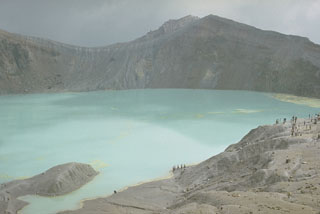Report on Kusatsu-Shiranesan (Japan) — October 1987
Scientific Event Alert Network Bulletin, vol. 12, no. 10 (October 1987)
Managing Editor: Lindsay McClelland.
Kusatsu-Shiranesan (Japan) Earthquakes increase to five times monthly average
Please cite this report as:
Global Volcanism Program, 1987. Report on Kusatsu-Shiranesan (Japan) (McClelland, L., ed.). Scientific Event Alert Network Bulletin, 12:10. Smithsonian Institution. https://doi.org/10.5479/si.GVP.SEAN198710-283120
Kusatsu-Shiranesan
Japan
36.618°N, 138.528°E; summit elev. 2165 m
All times are local (unless otherwise noted)
Many small volcanic earthquakes were recorded 14-19 October by the seismograph 1 km NE of Yugama, the largest of the three crater lakes. The monthly total of volcanic earthquakes reached 114, compared to the monthly average of less than 20. Seismic activity declined to a low level after 22 October. Epicenters were estimated to be several hundred meters E of Yugama. JMA's Mobile Volcanological Observation Team established two additional seismographs and began 10 days of observation on 18 October. No significant changes in fumarolic activity were observed during field surveys on 23 and 26 October.
A phreatic explosion from Yugama crater ejected 20-cm blocks to 600-700 m from the crater lake on 13 November 1983. Small phreatic explosions occurred from Yugama and Karegama (the E crater lake) on 26 July and 21 December 1983.
Geological Summary. The Kusatsu-Shiranesan complex, located immediately north of Asama volcano, consists of a series of overlapping pyroclastic cones and three crater lakes. The andesitic-to-dacitic volcano was formed in three eruptive stages beginning in the early to mid-Pleistocene. The Pleistocene Oshi pyroclastic flow produced extensive welded tuffs and non-welded pumice that covers much of the E, S, and SW flanks. The latest eruptive stage began about 14,000 years ago. Historical eruptions have consisted of phreatic explosions from the acidic crater lakes or their margins. Fumaroles and hot springs that dot the flanks have strongly acidified many rivers draining from the volcano. The crater was the site of active sulfur mining for many years during the 19th and 20th centuries.
Information Contacts: JMA.

